India, a land of diverse cultures and stunning landscapes, offers an incredible array of travel experiences. From the serene backwaters of Kerala to the majestic forts of Rajasthan, this country is a treasure trove of beautiful places. In this blog, we’ll take you on a virtual journey through the top 10 most beautiful tourist place in India.
Let’s Start Our Journey; I will Make You travel Top 10 tourist place In India
1. Taj Mahal, Agra, Uttar Pradesh
Our journey begins with a symbol of eternal love, the Taj Mahal. Located in Agra, Uttar Pradesh, this exquisite marble mausoleum is a UNESCO World Heritage site and one of the New Seven Wonders of the World. Commissioned by Mughal Emperor Shah Jahan in memory of his beloved wife, Mumtaz Mahal, the Taj Mahal is a testament to the grandeur of Mughal architecture. The pristine white marble, intricate inlay work, and the Taj’s reflection in the surrounding gardens are awe-inspiring. To fully appreciate its beauty, visit sunrise or sunset when the monument bathes in a soft, golden glow. Let’s Explore the Taj Mahal.
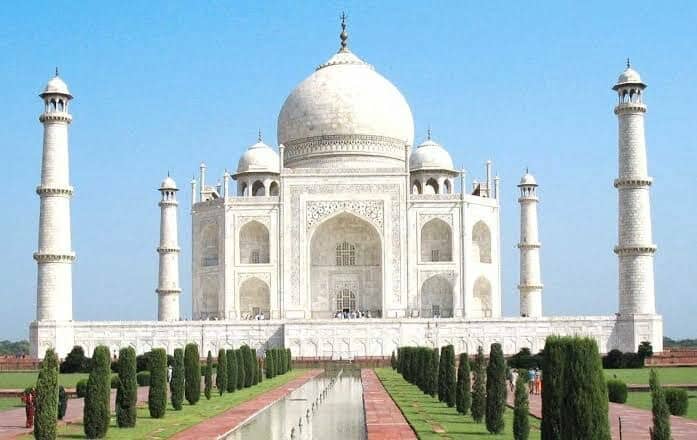
A Symbol of Love: The Taj Mahal was built by Emperor Shah Jahan in memory of his beloved wife, Mumtaz Mahal, who passed away during childbirth. The story of its creation is a tale of undying love and devotion, which adds a profound layer of meaning to the monument’s beauty.
Architectural Grandeur: The Taj Mahal is a prime example of Mughal architecture, known for its symmetry, white marble facade, and intricate inlay work. The detailing on the walls and the intricate calligraphy adoring the monument are awe-inspiring. As you approach the Taj through the grand entrance gate, you’re met with a view of the perfectly symmetrical gardens and the reflecting pool that stretches toward the main building.
Sunrise or Sunset: To fully appreciate the Taj Mahal’s beauty, visit at sunrise or sunset. During these times, the soft golden light bathes the monument in a warm, ethereal glow, creating a truly magical atmosphere. It’s no wonder that many consider these moments the best time to capture the perfect photograph.
Historical Significance: Beyond its stunning appearance, the Taj Mahal is significant in Indian history. It symbolizes the Mughal Empire’s architectural and artistic prowess during the 17th century. The architectural elements, including the white marble, calligraphy, and intricate carvings, reflect a fusion of Persian, Indian, and Islamic influences.
Travel Tips:
- Arrive early in the morning to avoid the crowds and witness the Taj in the soft, early light.
- Be respectful and follow the rules and regulations, as this is a place of historical and cultural importance.
- Explore the nearby Agra Fort, which also offers fantastic views of the Taj Mahal across the Yamuna River.
2. Jaipur, Rajasthan
Now It is Time to Move To Jaipur. Known as the Pink City, Jaipur is the capital of Rajasthan and a city filled with architectural wonders. Its stunning palaces, forts, and vibrant markets are a testament to the luxury of the Rajput era. The Amber Fort, perched on a hill, offers breathtaking views of the surrounding landscape. The City Palace, with its courtyards and museums, showcases the history of the royal family. Let’s Explore Jaipur
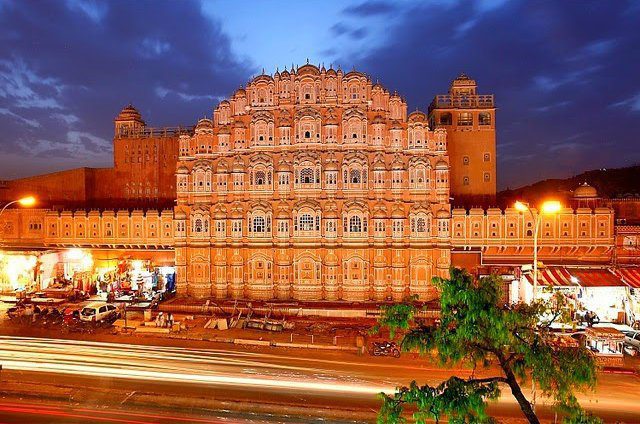
Architectural Marvels: The architecture of Jaipur is a testament to the grandeur of the Rajput rulers. The city boasts magnificent palaces, forts, and Havelis, each with a unique story. The Amber Fort, located on a hilltop overlooking Maota Lake, is a prime example of Rajput architecture. Its grand courtyards, intricate mirror work, and sweeping views of the surrounding landscape are truly awe-inspiring.
City Palace: The City Palace, a royal residence in the heart of Jaipur, is a beautiful complex of courtyards, gardens, and museums. It offers visitors a glimpse into the royal history of Rajasthan and houses an impressive collection of art and artifacts.
Hawa Mahal: The iconic Hawa Mahal, or “Palace of Winds,” is a stunning facade with 953 small windows (jharokhas) that allowed the royal women to observe street festivities without being seen. Its intricate latticework is a visual treat, both from the outside and from within.
Shopping Paradise: Jaipur is a paradise for shoppers. The local markets are brimming with traditional Rajasthani handicrafts, jewelry, textiles, and colorful clothing. The Johari Bazaar is renowned for its precious and semi-precious gemstones and jewelry. Remember to explore the bustling bazaars around the City Palace for souvenirs and local handicrafts.
Cultural Experiences: Jaipur offers a wealth of cultural experiences. You can witness traditional Rajasthani dance and music performances at venues like Chokhi Dhani or the Amer Fort. These performances provide a taste of the rich local culture.
Cuisine: Jaipur’s cuisine is a delightful fusion of sweet and savory flavors. Don’t miss the opportunity to try local dishes like dal baati churma (lentils, baked wheat balls, and a sweet dish), gatte ki sabzi (gram flour dumplings in a spicy gravy), and the iconic Rajasthani thali that offers a variety of traditional dishes.
Travel Tips:
- Jaipur can get very hot during the summer months, so plan your visit during the cooler seasons.
- Hire a local guide to get deeper insights into the history and culture of the city.
- The City Palace can get crowded, so visit early in the morning to avoid the crowds.
3. Varanasi, Uttar Pradesh
Moving to the spiritual heart of India, we arrive at Varanasi, one of the oldest continuously inhabited cities in the world. Situated on the banks of the sacred Ganges River, this city is a center for Hindu culture and spirituality. Witness the mesmerizing Ganga Aarti, a daily ritual performed at the Dashashwamedh Ghat, where priests offer prayers to the river. Let’s Explore this sacred City of Varanasi.
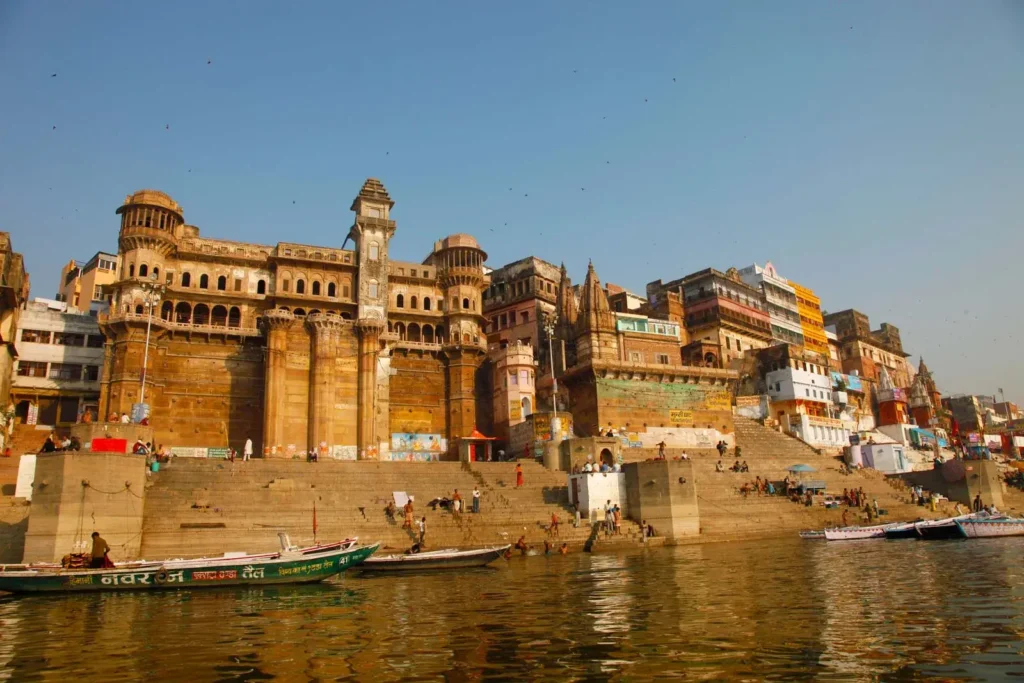
Spiritual Haven: Varanasi is a pilgrimage site for Hindus and one of the seven holiest cities in Hinduism. Devotees flock to the city to cleanse their souls by dipping in the holy Ganges River. The daily rituals and ceremonies on the ghats (steps leading down to the river) are a sight to behold. The Ganga Aarti, held at the Dashashwamedh Ghat, is a mesmerizing ritual where priests offer prayers to the river while holding lamps. The evening aarti, with the river aglow with flickering lamps, is a captivating experience.
Ghats: Varanasi boasts numerous ghats, each with its unique significance. Dashashwamedh Ghat is the most famous, but other ghats like Manikarnika Ghat, where cremations occur, and Assi Ghat, known for its tranquil atmosphere, are equally fascinating. A boat ride along the ghats at sunrise or sunset provides a deeper understanding of the city’s spiritual essence.
Kashi Vishwanath Temple: One of the most revered Hindu temples in India, the Kashi Vishwanath Temple, dedicated to Lord Shiva, is a must-visit. The temple’s intricate design and religious importance draw pilgrims and tourists alike. Be sure to witness the divine aarti at this temple as well.
Silk Weaving: Varanasi is renowned for its exquisite silk weaving. The city is famous for producing Banarasi silk sarees, which are known for their intricate designs and quality. Visit the silk weaving workshops to see the artisans and purchase a timeless piece of Banarasi silk as a keepsake.
Sarnath: Just a short distance from Varanasi, Sarnath is where Lord Buddha gave his first sermon after enlightenment. The Dhamek Stupa and the Sarnath Archaeological Museum are key attractions for those interested in Buddhism and ancient history.
Cuisine: Take advantage of the opportunity to savor the local vegetarian cuisine, including kachori-sabzi, chaat, and lassi. Varanasi is also famous for its sweet treats, particularly the world-renowned “Benarasi paan,” a chewable preparation of betel leaf.
Travel Tips:
- Varanasi can be extremely hot in the summer and quite cold in the winter, so choose your visit time carefully.
- Be respectful of local customs and traditions, especially when visiting the ghats and temples.
- Engage with locals listen to their stories, and you’ll gain a deeper understanding of the city’s spiritual and cultural significance.
4. Kerala Backwaters
From the bustling streets of Varanasi, we head to the tranquil Kerala Backwaters. This unique ecosystem of canals, lagoons, and lakes is a haven for nature lovers. Explore these serene waters on traditional houseboats, known as ‘kettuvallams.’ As you drift along, you’ll be surrounded by lush greenery, charming villages, and wildlife. It’s a perfect escape from the hustle and bustle of city life. Let’s Explore The beauty of Kerala.
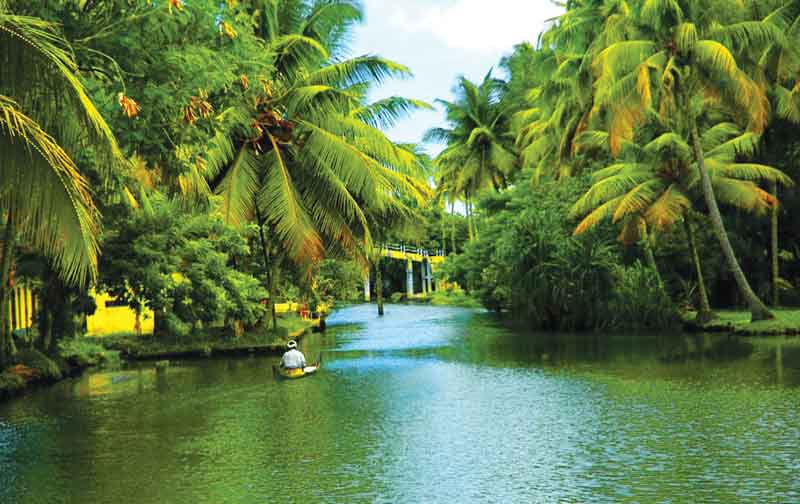
Majestic Backwaters: The Kerala Backwaters consist of a complex network of lagoons, canals, lakes, and rivers that traverse the coastal regions of the state. The meeting of several rivers forms these backwaters and is a crucial part of Kerala’s culture and economy.
Houseboats: Exploring the backwaters is a delightful experience, and one of the best ways to do so is by renting a traditional houseboat, known as a “kettuvallam.” These beautifully crafted houseboats come in various sizes, from small ones suitable for couples to larger ones designed for families or groups. They are equipped with modern amenities and offer a comfortable, leisurely journey.
Scenic Beauty: As you gently glide along the backwaters, you’ll be surrounded by lush green paddy fields, coconut groves, and small villages. The waters are teeming with various aquatic life, and the air is filled with the soothing sounds of nature. The reflections of the swaying palm trees on the calm waters create a magical, almost surreal, atmosphere.
Local Life: Along the way, you’ll be able to observe local life in the villages that line the backwaters. You’ll see children playing by the water’s edge, fishermen casting their nets, and women washing clothes. It’s a glimpse into the authentic, slow-paced way of life in this region.
Cuisine: The houseboat experience is not just about the views but also the food. The on-board chef prepares delicious Kerala cuisine, including fresh seafood, coconut-based dishes, and flavorful curries. Dining on the deck as the sun sets over the backwaters is a truly unforgettable experience.
Bird Watching: The backwaters are also a paradise for birdwatchers. You’ll spot avian species, including kingfishers, herons, and eagles, making it a haven for nature enthusiasts.
Cultural Encounters: While cruising the backwaters, you can visit local markets and villages to interact with the warm and welcoming people of Kerala. Many houseboat operators offer guided tours, which allow you to explore the culture and traditions of the region.
Travel Tips:
- The best time to visit the Kerala Backwaters is during the dry season, from October to March when the weather is pleasant and conducive to outdoor activities.
- It’s a good idea to book your houseboat in advance, especially during the peak tourist season.
- Mosquito repellent and sunscreen are essential, as you’ll spend much time outdoors.
5. Leh-Ladakh, Jammu and Kashmir
For those seeking adventure and unparalleled natural beauty, visiting Leh-Ladakh in Jammu and Kashmir is a must. This region is a haven for trekkers, with its high mountain passes and stunning landscapes. The clear blue lakes of Pangong Tso and Tso Moriri are a visual treat. The unique Buddhist monasteries, including Hemis and Thiksey, offer a glimpse into the spiritual side of this rugged land. Lets Explore this Hilly Place.
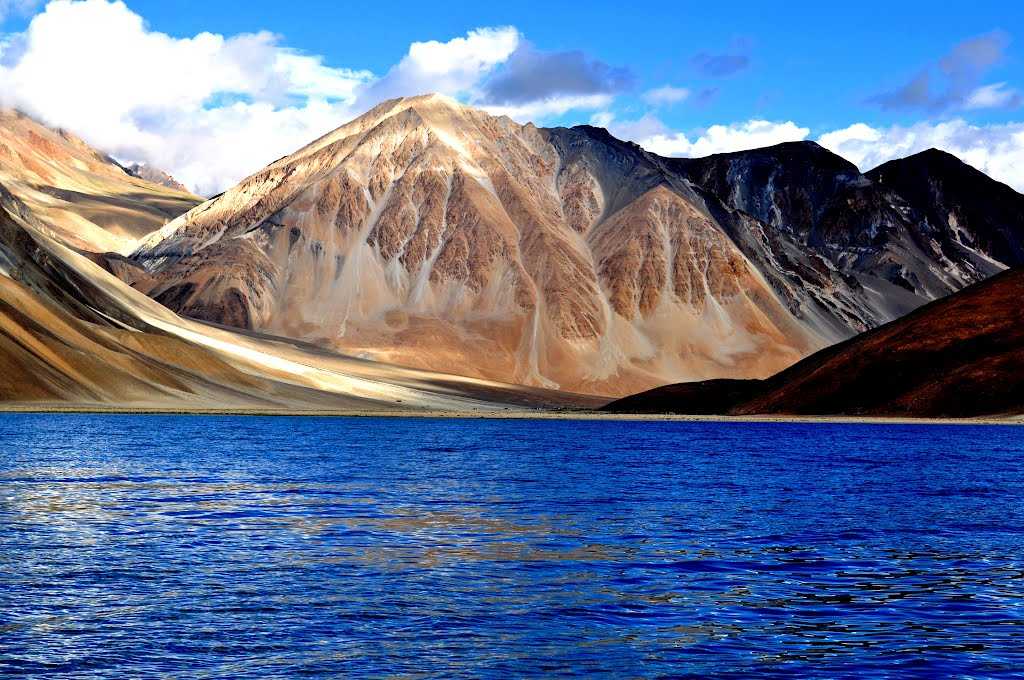
Nubra Valley: One of the most picturesque valleys in Ladakh, Nubra is known for its stark beauty and the iconic Bactrian camels. Take a camel safari in the dunes of Hunder and marvel at the vast, dramatic landscapes surrounding you.
Pangong Tso: The enchanting Pangong Lake, situated at an altitude of 4,350 meters, is known for its ever-changing shades of blue. Famous for being featured in the movie “3 Idiots,” this lake is a visual delight. Spend the night at one of the camps around Pangong for a truly unique experience.
Monasteries: Ladakh is home to some of the most beautiful Buddhist monasteries in the world. The Hemis Monastery, Thiksey Monastery, and Diskit Monastery are not only spiritual havens but also architectural marvels perched on dramatic hilltops. The centuries-old traditions and vibrant festivals add to their allure.
Chang La Pass: At 5,360 meters, Chang La is among the world’s highest motorable passes. The views from the top are nothing short of spectacular, and you’ll find a small temple, the Chang La Baba Mandir, worth a visit.
Trekking: Ladakh is a trekker’s paradise. Embark on adventures like the Markha Valley Trek, Chadar Trek, or the Stok Kangri Summit to experience the raw, untouched beauty of the region.
Ladakhi Cuisine: Don’t forget to savor the local cuisine, which includes delicious momos (dumplings), thukpa (noodle soup), and apricot-flavored dishes. The simple yet flavorful Ladakhi food reflects the region’s culture.
Travel Tip:
Due to the high altitude, it’s important to acclimatize properly and be prepared for temperature fluctuations. It’s advisable to visit in the summer months when most roads and passes are open and accessible.
6. Goa
The sandy shores of Goa are world-renowned. Known for its beautiful beaches, rich Portuguese heritage, and vibrant nightlife, Goa is a destination that caters to all kinds of travelers. Whether you’re seeking relaxation on the beaches of Palolem or partying at the clubs in Anjuna, Goa has it all. The state’s unique blend of Indian and Portuguese culture is evident in its architecture, cuisine, and traditions. Let’s explore the beach of Goa.

Golden Beaches: Goa is famous for its pristine and sun-kissed beaches that stretch along the Arabian Sea. From the lively and vibrant Baga Beach to the serene and peaceful Palolem Beach, there’s a beach for every kind of traveler. You can relax on the sandy shores, take part in water sports, or simply soak up the tropical atmosphere.
Historical Legacy: The influence of Portuguese colonial rule is evident in Goa’s architecture, cuisine, and culture. Explore the historic city of Old Goa, home to stunning churches and cathedrals like the Basilica of Bom Jesus and Se Cathedral. These UNESCO World Heritage sites are not only architectural marvels but also hold historical significance.
Forts: Perched on cliffs and hills, Goa’s forts provide not only historical insights but also breathtaking views of the coastline. The Aguada Fort and Chapora Fort are prime examples of Goa’s military heritage. The Chapora Fort, made famous by the Bollywood movie “Dil Chahta Hai,” offers a panoramic view of Vagator Beach.
Water Sports: For adventure seekers, Goa offers an array of water sports, from parasailing and jet-skiing to scuba diving and snorkeling. The warm, clear waters of the Arabian Sea make it an ideal location to explore underwater life and coral reefs.
Nightlife: Goa’s nightlife is legendary, with beach shacks, bars, and clubs that come alive after sunset. Enjoy live music, dance to the tunes of renowned DJs, and mingle with travelers from all over the world in popular party hubs like Anjuna and Calangute.
Cuisine: Goan cuisine is a delectable fusion of Indian and Portuguese flavors. Try traditional dishes like Vindaloo, a spicy pork curry, and Bebinca, a mouthwatering dessert. Fresh seafood is abundant, and you can enjoy it at the beachside shacks or in upscale restaurants.
Flea Markets: Goa’s vibrant flea markets, like the Anjuna Flea Market and Mapusa Market, offer a treasure trove of souvenirs, jewelry, clothing, and local handicrafts. These markets are perfect for shopping and discovering unique finds.
Festivals: Goa celebrates festivals enthusiastically, including Carnival, Shigmo, and Christmas. These events are a testament to the state’s rich cultural heritage and provide a unique opportunity to witness the fusion of Indian and Portuguese traditions.
Travel Tips:
- Goa is a year-round destination, but the peak season is from October to March, when the weather is most pleasant.
- Public transportation is available, but it’s a good idea to rent a scooter or car to explore the state at your own pace.
- While enjoying the beaches and watersports, follow safety guidelines to ensure a memorable and safe experience.
7. Rann of Kutch, Gujarat-The White Desert of India
The vast expanse of the Rann of Kutch is unlike any other landscape in India. Located in Gujarat, this seasonal salt marsh becomes a surreal, glistening white desert during the dry season. The annual Rann Utsav, a cultural festival, celebrates the art, music, and crafts of the region. Watching the full moon rise over this expansive white desert is an experience that’s hard to put into words. Let’s Explore the white desert of India.
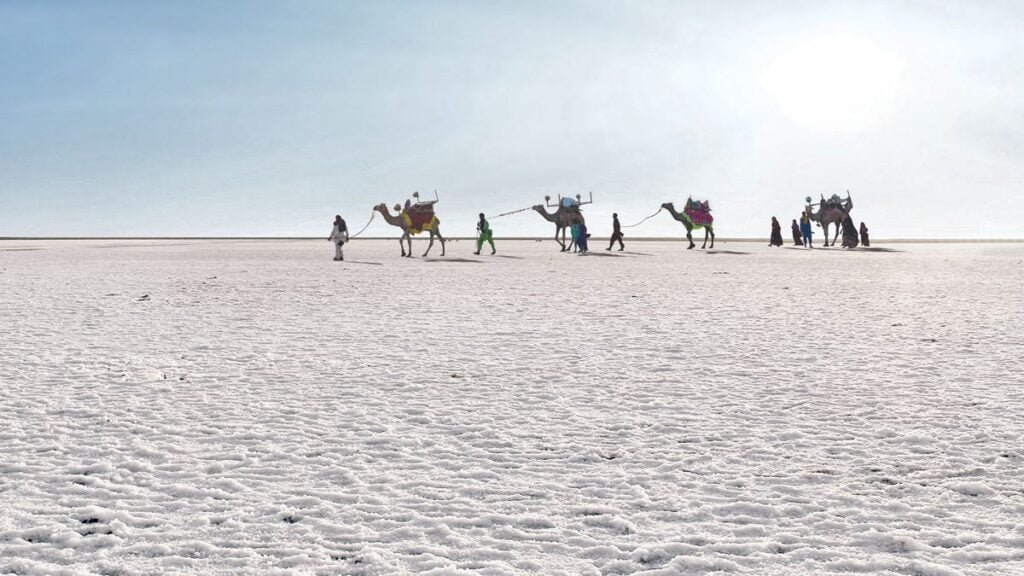
Surreal Landscape: The Rann of Kutch is the world’s largest salt desert and is like no other place on Earth. During the dry season, the desert is a glistening, blindingly white expanse that stretches as far as the eye can see. It’s a photographer’s dream and an ideal backdrop for stargazing at night.
Rann Utsav: The Rann of Kutch comes alive during the Rann Utsav, an annual cultural festival that celebrates the art, music, crafts, and heritage of the region. The festival offers an opportunity to experience the rich culture of the Kutchi people, with traditional dance performances, local cuisine, and the chance to shop for exquisite handcrafted goods.
Handicrafts: Kutch is renowned for its handicrafts, particularly its intricate embroidery, bandhani tie-dye, and beautiful textile art. While in the region, you can visit villages and workshops to witness the artisans at work and purchase unique, handmade souvenirs.
Wildlife: The Rann is not just a desert; it’s also home to a diverse range of wildlife. The nearby Indian Wild Ass Sanctuary is the last refuge for the endangered Indian Wild Ass. These species have adapted to this unique habitat. It’s also a haven for birdwatchers, with various migratory birds making the Rann their winter home.
Full Moon Magic: The Rann of Kutch is enchanting during a full moon night. As the moonlight bathes the salt desert, it creates a surreal and almost mystical ambiance perfect for nighttime photography and moonlit walks.
Kutchi Cuisine: Don’t miss the opportunity to savor the local cuisine, which includes dishes like dhokla, thepla and traditional sweets like jalebi and rabri. The region’s cuisine offers a blend of flavors and spices that will tantalize your taste buds.
Travel Tips:
- The Rann is best visited during the dry season, typically from October to March. During the monsoon season, the area is flooded and inaccessible.
- Plan your visit during the Rann Utsav if you want to experience the cultural richness of the region.
- Given the remote nature of the Rann, it’s a good idea to hire a local guide who can provide insights into the region’s culture and history.
8. Darjeeling, West Bengal
If you’re a lover of cool, pleasant weather and lush landscapes, Darjeeling in West Bengal is a must-visit. This picturesque hill station, located in the Himalayan foothills, is famous for its tea plantations. The Darjeeling Himalayan Railway, a UNESCO World Heritage site, offers a scenic ride through the town’s tea gardens, and the Tiger Hill viewpoint is the place to be for a stunning sunrise over the Himalayas. Let’s explore this beautifull place.
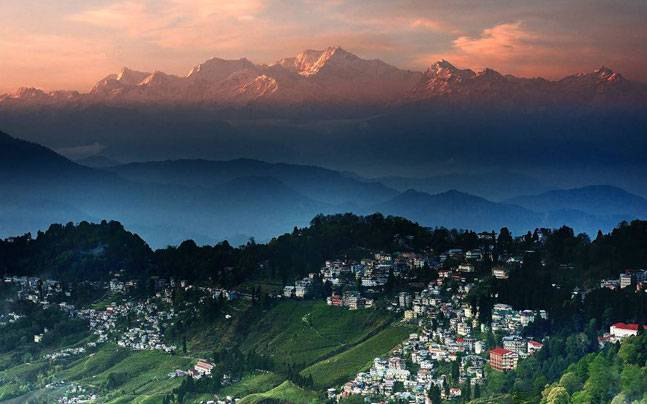
Tea Plantations: Darjeeling is synonymous with tea, and its verdant tea gardens produce some of the finest and most sought-after teas in the world. A visit to a tea estate, such as the Happy Valley Tea Estate, provides a fascinating insight into the tea-making process. You can tour the plantations, watch tea pluckers at work, and even sample freshly brewed tea with breathtaking views of the Himalayas as your backdrop.
Darjeeling Himalayan Railway: A UNESCO World Heritage site, the Darjeeling Himalayan Railway is a unique and delightful experience. The toy train, as it’s affectionately called, chugs through picturesque landscapes, crossing bridges and tunnels as it ascends steep gradients. The journey offers panoramic views of the town and surrounding hills.
Kanchenjunga: Darjeeling is the gateway to one of the world’s highest peaks, Mount Kanchenjunga. The Himalayan giant provides a dramatic backdrop to the town, and viewing the sunrise over Kanchenjunga from the Tiger Hill viewpoint is a mesmerizing experience.
Ghoom Monastery: The Yiga Choeling Monastery in Ghoom, one of the oldest Tibetan Buddhist monasteries in the region, is a place of serenity and spirituality. It houses a magnificent 15-foot-high Maitreya Buddha statue and ancient thangka paintings.
Darjeeling Zoo: The Padmaja Naidu Himalayan Zoological Park is home to some of the world’s rarest and most endangered animals, including the snow leopard and red panda. The zoo plays a vital role in wildlife conservation efforts.
Batasia Loop: Located on the way to Ghoom, the Batasia Loop is a unique railway loop that offers panoramic views of Darjeeling and Kanchenjunga. It’s a perfect spot for train enthusiasts and photographers.
Local Cuisine: Take advantage of the opportunity to savor local dishes like momo (dumplings), thukpa (noodle soup), and traditional Tibetan fare. Also, enjoy a cup of rich, aromatic Darjeeling tea at one of the charming teahouses in town.
Cultural Diversity: Darjeeling is home to a diverse population, and you’ll find a mix of Gorkhas, Tibetans, and Lepchas living harmoniously. This cultural diversity is reflected in the local festivals and traditions.
Travel Tips:
- Darjeeling can be visited year-round, but the best time to enjoy clear mountain views is during the autumn months, from September to November.
- The town’s high elevation can result in chilly temperatures, so pack accordingly.
- For the best experience, consider hiring a local guide to help you explore the tea gardens, monasteries, and other attractions.
9. Rajasthan’s Thar Desert
Rajasthan’s Thar Desert is a stark, golden landscape that provides a unique and picturesque setting. From the dunes of Jaisalmer to the desert cities of Bikaner and Jodhpur, this region is a land of royalty and rustic charm. Take a camel safari into the heart of the desert, spend a night under the starry sky in a desert camp, and immerse yourself in the rich cultural heritage of the desert communities. Let’s explore this beautifull desert.
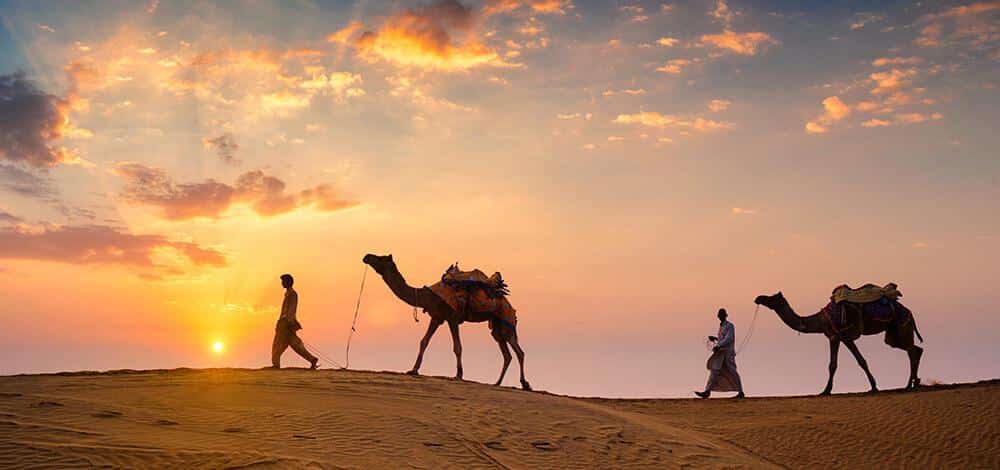
Golden Sand Dunes: The Thar Desert is renowned for its mesmerizing dunes, with the most famous being in the region of Jaisalmer. The rolling dunes stretch as far as the eye can see, creating a surreal and tranquil atmosphere. Witnessing a desert sunset or sunrise is an experience that will stay with you forever.
Jaisalmer – The Golden City: Jaisalmer, often called the “Golden City,” is the crown jewel of the Thar Desert. The town’s architecture, constructed from the local golden sandstone, creates a striking, shimmering effect in the desert sunlight. Explore the stunning Jaisalmer Fort, visit the intricately designed havelis (mansions), and immerse yourself in the desert life.
Camel Safaris: A camel safari through the Thar Desert is a quintessential experience. Trained guides and camel handlers will lead you through the desert, allowing you to traverse the dunes, witness desert wildlife, and camp under the star-studded desert sky.
Desert Culture: The Thar Desert has a vibrant culture with unique traditions, music, and cuisine. Enjoy traditional folk music and dance performances, savor local dishes like dal baati churma, and participate in desert festivities, such as the desert festivals in Jaisalmer and Pushkar.
Khuri and Sam Dunes: Beyond Jaisalmer, the villages of Khuri and Sam offer a more tranquil desert experience. The dunes in these areas are equally enchanting. You can enjoy camel rides, cultural shows, and overnight stays in desert camps.
Historic Forts: Apart from Jaisalmer Fort, the Thar Desert is home to other historic forts like Jodhpur’s Mehrangarh Fort and Bikaner’s Junagarh Fort. These architectural marvels provide insight into the region’s history and offer panoramic views of the surrounding landscape.
Wildlife: The Thar Desert is not just about sand; it’s also a habitat for unique desert wildlife. You may spot blackbucks, desert foxes, gazelles, and various bird species while exploring the desert.
Travel Tips:
- The Thar Desert can be extremely hot during the day and chilly at night, so dress in layers and stay hydrated.
- Consider visiting in the cooler months, from October to March.
- Engage with the local communities to gain a deeper understanding of the desert culture and lifestyle.
10. Munnar, Kerala
Our final stop is the idyllic hill station of Munnar in Kerala. Nestled amidst lush green tea plantations and misty hills, Munnar is a paradise for nature lovers. Explore the Eravikulam National Park, home to the endangered Nilgiri Tahr, and walk through the tea gardens. The cool climate, pristine landscapes, and tea aroma make Munnar a perfect destination for relaxation and rejuvenation. Let’s explore our last destination, and finally, we will get some rest after this wonderful Trip.
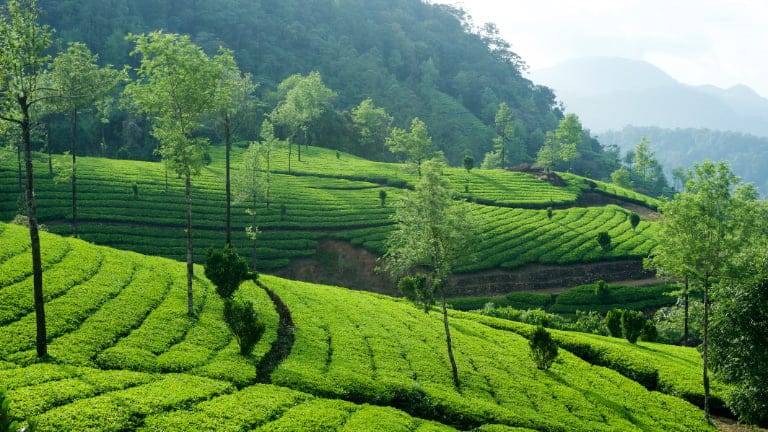
Tea Plantations: Munnar is synonymous with tea, and its vast tea estates, like Kolukkumalai Tea Estate and Lockhart Tea Museum, are a visual delight. Stroll through the emerald-green tea plantations, breathe in the fresh mountain air, and take guided tours to learn about the tea-making process.
Mattupetty Dam: Located at a higher altitude, the Mattupetty Dam is surrounded by lush forests and rolling hills. The reservoir offers opportunities for boating, and you might catch a glimpse of elephants and other wildlife along the shores.
Anamudi: The highest peak in South India, Anamudi, is a challenging trekking destination that provides breathtaking views of the surrounding landscape. The trek through Eravikulam National Park is an opportunity to spot the Nilgiri Tahr, a rare mountain goat species.
Eravikulam National Park: This national park is a protected area for the Nilgiri Tahr and a variety of flora and fauna. The park’s lush grasslands and rolling hills make it a stunning backdrop for trekking and wildlife observation.
Atukal Waterfalls: Located near Munnar, the Atukal Waterfalls cascade gracefully through lush forests. The site is perfect for a refreshing break and a chance to enjoy the cool mist generated by the falls.
Wildlife: Munnar’s surroundings are home to various wildlife, including elephants, tigers, leopards, and many bird species. The Chinnar Wildlife Sanctuary is an excellent place for wildlife enthusiasts and birdwatchers.
Munnar Tea Museum: The Munnar Tea Museum offers insights into the history and evolution of tea production in the region. It’s an educational and fascinating experience for tea lovers.
Local Cuisine: Savor Kerala’s delicious cuisine, including South Indian dishes like dosa, idli, and sambhar. Take advantage of the local specialties like appam with stew or puttu with kadala curry.
Travel Tips:
- Munnar enjoys a pleasant climate throughout the year. Still, the best time to visit is during the dry season from September to March.
- Given the hilly terrain, be prepared for cooler evenings, even during the warmer months.
- Exploring Munnar is best done by hiring a local guide who can provide in-depth knowledge of the region.










